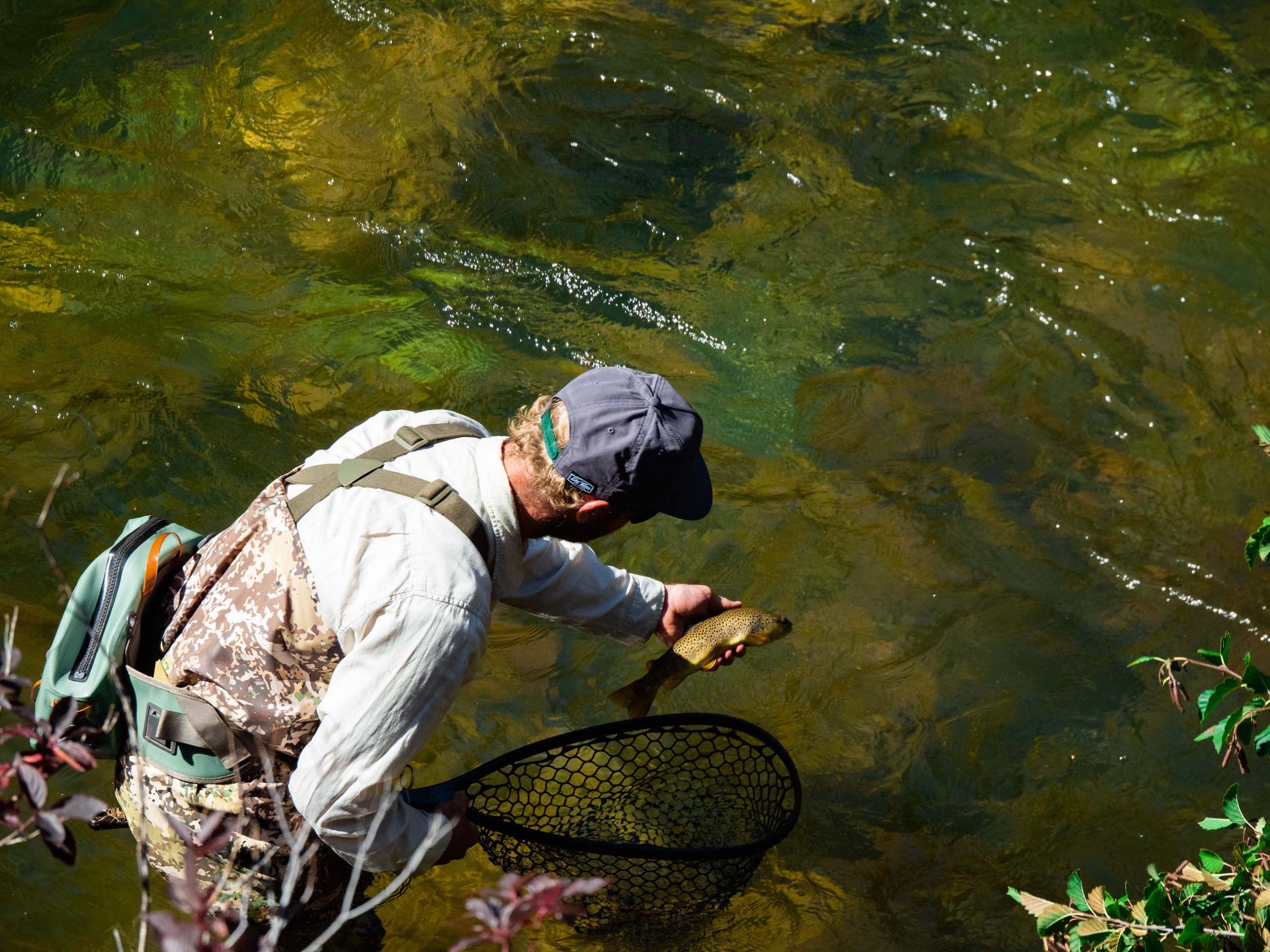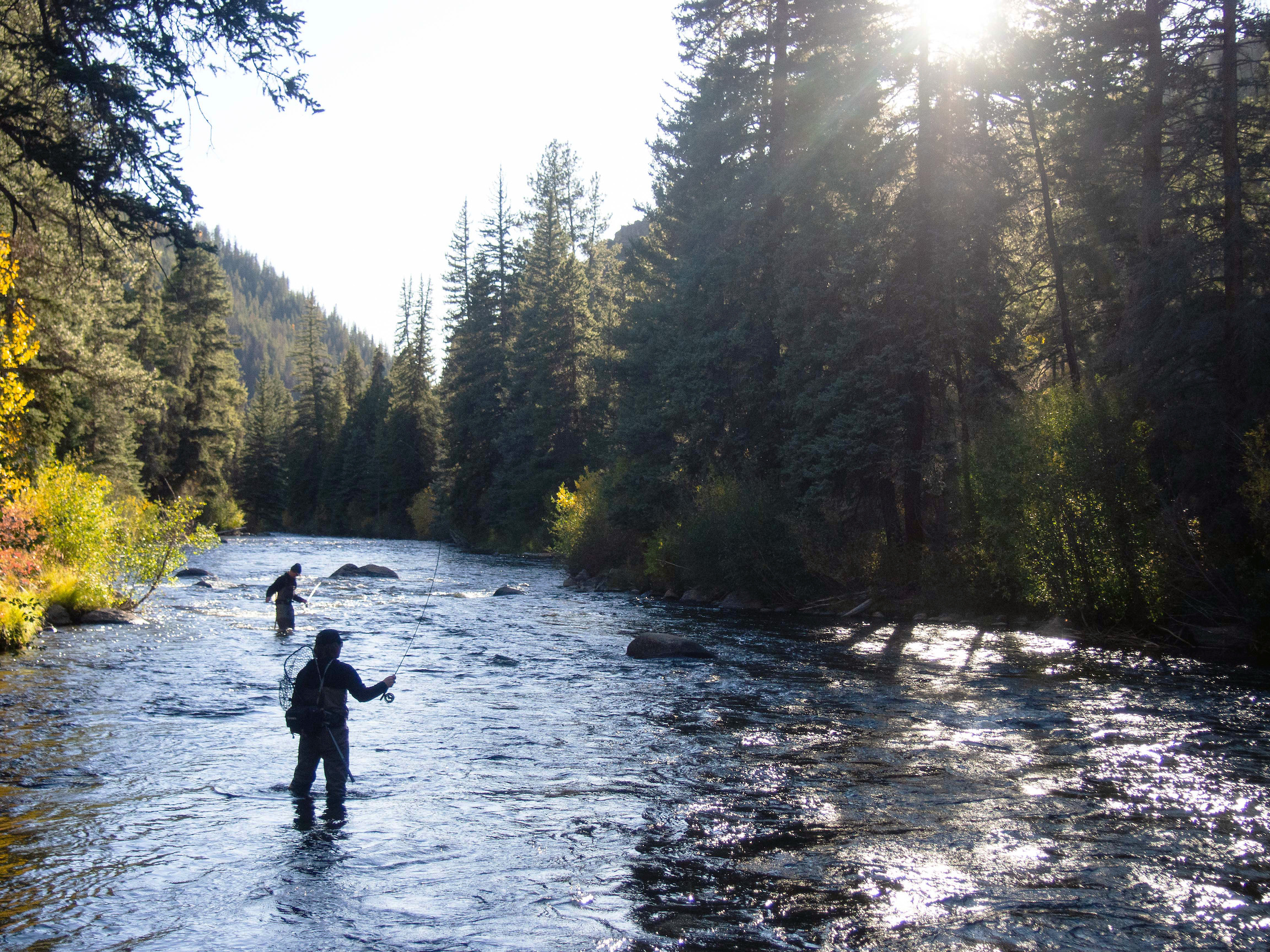5 Tips for Colorado Spring Fly Fishing in the Gunnison Valley
Spring is a secret season of excellent fishing throughout the Rockies, but in particular in the Gunnison Valley. Our low elevation snowpack has melted off and our consistent mix of bluebird days mixed with snow and moisture helps keep water levels prime for a Colorado Spring fly fishing sojourn.
For locals spring means off-season and it’s a time to relax after a busy winter of skiing. For some that means escaping to lower elevations and the desert. For others it means the Colorado Spring fly fishing season, and quite possibly the best chance at a big fish on the Gunnison or one of its main tributaries: the East or the Taylor.
If quiet days on the water and hungry fish appeal to your sensibilities, here are five tips for making the most out of a Colorado Spring fly fishing trip to the Gunnison Valley.

1. Strip Strip Set
Once the water and weather start to warm a bit, spring can bring great streamer fishing on the Gunnison. In general, streamers work best when the water has a bit of tint, but can be a great way to lure large trout into a strike anytime during the spring.
The most productive time for streamer fishing is during and immediately after the Kokanee fry release from Roaring Judy Fish Hatchery. Typically the release is at dark on the first new moon of April, when the fish have the best chance of reaching Blue Mesa without being eaten. While thousands of fry make it to the Mesa, the trout of the East and Gunnison have a feast on any they can get their flippers on. Fish white streamer patterns like Meatwhistles, Muddler Minnows, and Mike’s Meal Ticket.
Once the fish are keyed off of the salmon fry, the streamer fishing can still be great. Olive patterns are consistent producers, but other natural colors work, too. Until the water visibility is low, stay away from flashy and bright patterns. Start off with an olive Woolly Bugger and then work up in size from there to Sculpzillas and Slumpbusters until you find something that produces well.
2. Learn the Taylor
The Taylor is the only dam release river in the Upper Gunnison River watershed. It provides consistent flows, clear water, and long stretches of public water. As the days warm up and the stain of runoff begins to appear, you can bet that the Taylor will remain clear enough to fish even on the hottest days.
In the 11 miles of public water from the dam to Almont, you’ll find tons of roadside pull-offs and sections that disappear from the road entirely offering seclusion from the rest of the world. Most of the Taylor’s campground are closed until around Memorial Day. Parking and fishing the sections behind these campgrounds like Rosy Lane and North Bank can yield fantastic results.
The Catch and Release section is the beginning of the Taylor River public water. This .5 mile of water directly below the dam is locally know as the C&R or Hog Trough. It can produce some of the largest fish in Colorado that feed off the mysis shrimp flushed through the dam. A mysis pattern is usually a good bet, but these fish get pressure all year long, even in the dead of winter, and are wary of pretty much anything. Make sure you take the lightest fluorocarbon tippet you can find, and make sure you have a full backup box of flies including midges, emergers, streamers, eggs, and a flossy worm or two. Small is usually the best bet, but going big with good presentation can pay off, too.
Below the C&R the river goes into a long stretch of private. Below here to Almont the fishing consists of similar tactics. Often times I’ll float a size 10 or 12 stonefly nymph like a Girdle Bug (Pat’s Rubber Legs) with a little weight, and a smaller nymph in the 14-20 range. Some of my favorite trailers are a Psycho Prince in purple or red, flashback Pheasant Tails, WD-40 emergers, and Two Bit Hookers.
Dry fly fishing is an option in the Colorado Spring fly fishing season as Blue Wing Olives start to come out. Some days the fish may be too lethargic to really get into the hatch, but fishing emergers behind dry patterns can be pretty successful.
The private water on the Taylor is usually pretty well marked, but it’s nice to have an app like onX Hunt if you plan on pushing up towards private land. At several of the boater specific launches the USFS has put up maps outlining land ownership. You can check those out at 5 Mile and South Bank.

3. Beat the Wind
As the days heat up in the Gunnison Valley it’s not uncommon to have some heavy winds kick up in the afternoon. Having a plan for beating the wind can be a necessity for having a fun time. One of the best tactics I’ve found is to fish the bigger, more open water in the mornings, and then move to smaller streams in the afternoon.
Spring Creek is a tributary of the Taylor and public water starts at the campground 3 miles up from the Taylor. The road isn’t plowed so you can only drive as far as the snow will allow, but you can hike as far up as you want after that. Much of the good sheltered fishing is in the lower canyon anyway and traffic should be pretty light.
Cement Creek is a little farther up the valley towards Crested Butte off County Road 740. In the spring the road ends at the large turnaround about 4 miles up from the highway. You can hike up .5 miles from there to access the meadow section, but if you’re trying to escape the wind I wouldn’t recommend that much effort. Try fishing the roadside section in the trees starting at Pioneer Guest Cabins to the end of the road. It’s tight and a smaller rod is a good bet, but this section doesn’t ever receive too much pressure. Nymphing is generally your best option, and you really don’t need to get too fancy for either Cement or Spring Creek.
4. Get Deep
It probably goes without saying, but nymphing is the name of the game for the majority of spring fishing in the Gunnison Valley. Fish are hiding in deep pockets on all rivers, and getting flies to them takes a bit of weight. Even with a stonefly pattern and tungsten beads I will usually throw a piece of splitshot on my rig. This can be especially true on the Taylor where deep runs and eddies have channelized in the riverbed.
Even on the smaller creeks like Spring or Cement I’ll use weight selectively to target big cut banks and steep dropoffs. These spots can be tough to fish because the water goes abruptly from 1″ deep to 3’+ and the casting zones require the upmost stealth in order to get a shot at what lurks beneath. Good luck!

5. Stay in Gunnison
Gunnison is the most centralized location for fishing in the valley. Almost every piece of water mentioned here is less than a 25 minute drive from downtown, and there are plenty of affordable places to stay. Another bonus is that Western State Colorado University is still in session so off season hits a little softer with fewer restaurants and retail businesses closed during the spring than in the resort town of Crested Butte.
Staying in Almont, 10 minutes north of Gunnison is another good option. This quaint community is located at the mouth of the Gunnison with access to the East, Taylor, and Upper Gunnison rivers. It also contains two fly fishing shops and plenty of knowledgeable locals to glean for information.
In addition to the water we’ve already mentioned there is great fishing on Tomichi Creek, Blue Mesa Reservoir, the Lake Fork of the Gunnison, Cebolla Creek, and Cochetopa Creek this time of year. For specific information on private/public land, flies, and other tips on these reaches we highly recommend picking up Doug Dillingham’s Fly Fishing the Gunnison Country online or at any fly shop in the valley.


